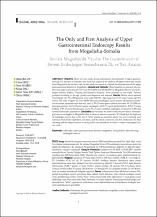The only and first analysis of upper gastrointestinal endoscopy results from Mogadishu-Somalia
Künye
Bulur, O., Baş, Y., Abdi, O. A., Dal, K., Ertuğrul, D. T., Ünsal, O. (2018). The only and first analysis of upper gastrointestinal endoscopy results from Mogadishu-Somalia. Türkiye Klinikleri Cardiovascular Sciences, 30(1), 1-5.Özet
Objective: There is’nt any study giving information about profiles of upper gastrointestinal (GI) diseases in Somalia; this study has reported the analysis of upper endoscopic results from Mogadishu for the first time. In this study we aimed to evaluate the distributions of the upper gastrointestinal diseases in Mogadishu. Material and Methods: Three hundred six patients who underwent upper GI endoscopy between 01.01.2015 and 20.04.2017 at Mogadishu Recep Tayyip Erdoğan Somalia-Turkey Training and Research Hospital were included in this study. Patients grouped according to the age, gender and diagnoses and assessed. Results: Ninety-seven patients were female (31.7%), 209 patients were male (68.3%). Age range was 16-97 years (mean age 47.9 years). The rates of upper GI were 18.0% (55 cases) esophageal cancer (nearly all patients had adenocarcinoma, squamous type was very rare), 2.3% (7 cases) gastric adenocarcinoma, 44.1% (135) endoscopic gastritis, 10.1% (31cases) peptic esophagitis, 4.3% (13 cases) duodenal ulcer, 4.3% (13 cases) bulbitis, 3.0% (9 cases) hiatal hernia, and 1.3% (4 cases) candidial esophagitis. 24 patients (7.8%) had normal endoscopic appearance. Conclusion: In our study we showed that the prevalence of esopha-gial cancer was higher in Mogadishu than in those of western countries. We think that the high rate of esophagus cancers due to the use of “khat” named an anxiolytic plant, too hot rice eating, poor nutrition from fresh vegetables and fruits, and the meals cooked in coal fire. Reduction the khat chewing and the improvements in eating habits are mandatory in order to reduce esophageal cancer cases. Copyright © 2018 by Türkiye Klinikleri. Somali’de üst gastrointestinal sistem (GİS) hastalıklarının profili ile ilgili bilgi veren bir çalışma bulunmamaktadır. Bu çalışma Mogadişu’da üst GİS endoskopisi sonuçlarının analizi ile ilgilili ilk çalışmadır. Bu çalışmada Mogadişuda üst GİS hastalıklarının dağılımı ile ilgili ilk değerlendirmeyi yapmayı amaçladık. Gereç ve Yöntemler: Çalışmaya 01.01.2015 ve 20.04.2017 tarihleri arasında Recep Tayyip Erdoğan Somali-Türk Eğitim Araştırma Hastanesinde Üst GIS endoskopisi yapılmış olan 306 hasta dahil edildi. Hastalar yaş, cinsiyet ve tanılarına göre gruplandırılarak değerlendirildi. Bulgular: Çalışmada 97 hasta kadın (%31,7), 209 hasta erkekti (%68,3). Yaş aralığı 16- 97 (ortalama 47,9) yıl idi. 55 hastada (%18,0) özofagus kanseri (hastaların tama yakını adenokarsinom tipte olup, skuamöz hücreli karsinom tip nadirdi), 7 hastada (%2,3) mide kanseri, 135 hastada (%44,1) gastrit, 31’inde (%10,1) peptik özofajit, 13 hastada (%4,3) bulbusta ülser, 13’ünde (%4,3) bulbit, 9 hastada (%3,0) herni ve 4 hastada (%1,3) kandidial özofajit, 24 (%7,8) hastada ise normal endoskopik bulgular saptandı. Sonuç: Çalışmamızda Batı ülkelerine nazaran Mogadişu’da özofagus kanseri prevelansı daha yüksek olarak bulundu. Daha yüksek özofagus kanseri oranı görülmesinin nedeni olarak “khat” isimli anksiyolitik bitki çiğnenmesi ve sıcak pirinç yeme alışkanlığı, taze sebze-meyveden fakir beslenme ve kömür ateşinde yemek pişirme alışkanlığını düşünmekteyiz. “Khat” çiğnemenin azaltılması, yeme alışkanlıklarının iyileştirilmesi özofageal kanserin azaltılmasında gereklidir.


















